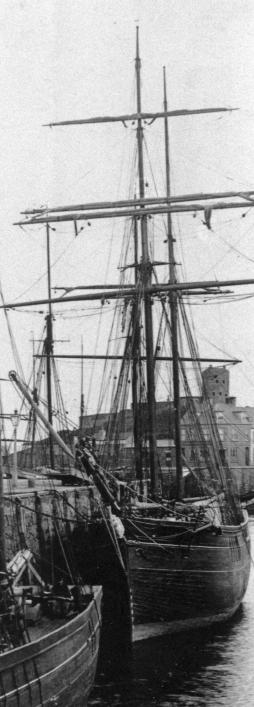The Launch of the 'Concordia'
1st August 2024
Witchcraft in action - literally with a pinch of salt. From a Report by J Linwood Pitts, Hon. Sec. of the Folklore Section of the Société Guernesiaise. The illustration is a photograph of a brigantine in St Peter Port Harbour, from the Priaulx Library's Photographic Collection. Please contact us if you wish to reproduce it.
"The last half century has seen many changes. When he first came to the island, a frequent subject of conversation, especially amongst those who lived out St Sampson's way, was the launch of the brigantine Concordia and the peculiar circumstances that characterised that launch. The vessel in question was, in 1836, built by Mr Stonelake, of St Sampson's, whose shipyard then occupied the ground that is now at the back of Mr Brehaut's grocery stores. As the Concordia was built and launched in 1836, some seventy-eight years have since elapsed (1914), and it naturally follows that all those who were old enough to take an active part in the affair have since passed away. Fifty years ago many were living who recollected the event, and they often talked about it. I may just mention here that I am indebted for the dates and several other particulars to Mr J M Le M Bougourd, the Agent of the Guernsey Steam Towing and Trading Company, who very kindly obtained them for me. Among those who helped to launch the vessel was Mr Peter Le Maitre, who was a shipwright by trade, and was Mr Bougourd's maternal grandfather. The family residence was next door to the shipyard, and the Le Maitres took a great interest in the whole affair. In later life, too, Mr Le Maitre often spoke of the matter to his grandson. The peculiar circumstances were these: When the Concordia was finished, and the day of the launch arrived, the usual 'ways' leading down to St Sampson's Harbour were laid across the road and the vessel was duly started on her course. She seemed to slide along alright for a little way and then, without any apparent cause, she stuck, and although she was comparatively a small and light vessel it was found impossible to move her further. Mr Stonelake and his assistants were all practical men, well accustomed to the work, and they tried all they knew to get her into the water. Ultimately, the 'ways' were reconstructed, a lifting-jack was applied, and each end of the hull was in turn raised quite clear of the bed on which it rested. But all to no avail. There the little craft firmly stuck. Neighbours, of course, began to stroll up to make remarks and give advice, most of them suggesting witchcraft as the detaining force. But this was repudiated on the part of the builders. It was further pointed out by the more credulous that a bird - probably a sea-gull - for whose presence no-one could account, kept mysteriously flying backward and forward across the vessel, and this circumstance was considered more than suspicious. At last some passer-by came up and he also strenuously asserted witchcraft. 'But it is no use merely talking about it', said he, 'let us put it to the test. I'll go and get some salt, an you bring a ladder so that I can get on the deck, and we'll soon prove whether it is witchcraft or not.' After returning with the salt, the man climbed onto the vessel's deck and scattered the salt around him; the mysterious bird immediately flew away and the Concordia at once, without any more urging, glided into the water. Such is the story. The facts do not seem, any of them, to be disputed. Hundreds of people, at the time, knew all the circumstances, though now the exact details are almost forgotten. The important question is: What caused the sudden change? Of course, to those who believe the witchcraft theory, the solution is self-evident. To those of us who do not believe on witchcraft, no explnatino ins forthcoming.
As regrds the general history of the Concordia, Mr Bougourd supplies the following particulars: When launched, in 1836, she was a vessel of 108 tons; thirty years later, in 1866, she was lengthened and partially rebuilt, when her register was raised to 125 tons. In this enlarged form she traded for another sixteen years, and then, in 1882, she was unfortunately lost on the Newcomb Sands, which lie a little to the south of Lowestoft."¹
¹ The rescue by the RNLI
